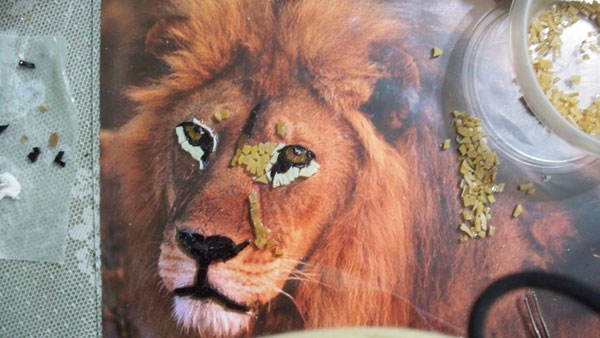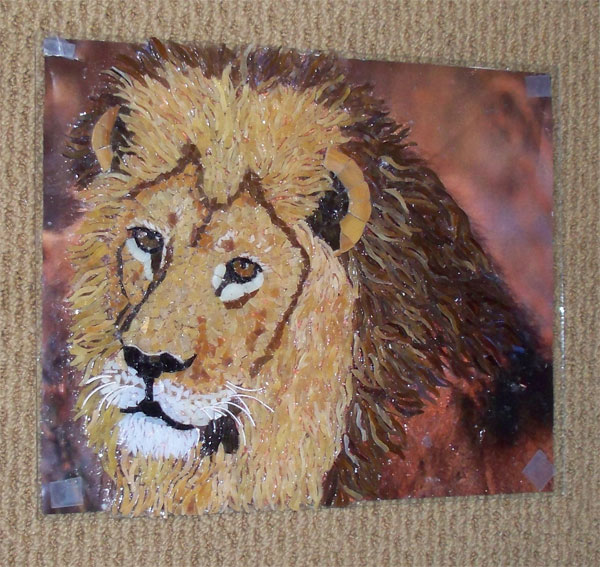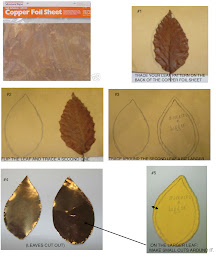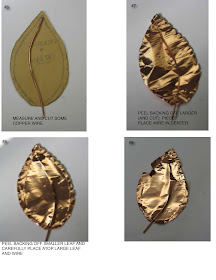This project once underway gets done in one sitting. I am playing with the placement of the polymer clay tiles and laying out the background paper.

I painted the mirror edge and frame edge prior to gluing the pc (polymer clay) tiles down with Mac glue.

Begin by applying the background paper using a two part epoxy. I spread the epoxy evenly and thoroughly before placing the paper, then smooth it out to ensure contact.

Work your way around the now papered background with the tempered glass. I brushed the epoxy on top of the paper. It did darken the red to a deeper shade but it still worked.

All the tempered glass is in place and let it dry overnight.

The mirror is now grouted. Prepare a mixture of gel medium, acrylic paints and mica powders to apply to the grey grout. Gel medium is available in art stores and Michael's, etc. I am using Liquitex Acrylic Gel Medium. I believe gel medium is normally used to extend the life of your paint so it doesn't dry as quickly. In this instance it makes a more even application of the paint and mica powders and is more workable.

I am using two colors, cardinal and gold as this is a USC mirror, to treat the grout and give it some bling. I just paint it on the grout lines, then rub it off. Sometimes it needs a damp paper towel to get it off the glass.

All cleaned up and just waiting to be sealed. This project was made with tempered glass, Ikea mirror, polymer clay tiles with metal embellishments, and red foil leaf.

The epoxy resin gives this piece real depth under the tempered glass. You can also use glitter, ribbon, etc. under the glass too. Here is another piece using glitter & ribbon under the tempered glass. I painted the background in different colors instead of a background paper.

You can follow Donna's work on Flickr by
clicking here.And our favorite forum to meet other mosaic friends is
Mosaic And Stained GlassA word from the author, Donna PostI have always been the "crafty" one in the family-I started out with tole painting, then progressed into quilting and knitting. i have always admired mosaics, especially used in the garden, but never thought much about trying it until December 2007. I found a couple on the internet, "Passiflora Mosaics", that offered various classes. It was near a favorite getaway spot my husband and I love to visit, so I thought I'd combine the two! Hubby got to beach comb during the day, I was introduced to mosaics. My first project was a birdbath using ceramic tiles. I was hooked! I returned in early 2008 and used stained glass for the first time and made a mushroom. At this point, I went from hooked to obsessed!!
I had been following a couple of forums and was amazed at the freely shared information from really fantastic artists. I had been following the saga of a trade between Susan Crocenzi and Kim Grant. Susan had posted little snippets of a piece she was making for Kim in exchange for her website Kim had developed. The piece was like nothing I'd ever seen before and I knew I HAD to learn to do it. That was my introduction to tempered glass and polymer clay tiles! I found out that Susan lived in California, like me, and that she held classes so sign me up!! I was blessed to be able to go to her cabin in the beautiful woods and learned her method of tempered glass and polymer clay. (and get to hang with Kim, who as luck would have it, was visiting Susan too)
Since then, I have loved experimenting with tempered glass and pc. I love the flexibility mixing these mediums provides. I've also moved forward and have been working with creating Styrofoam and concrete substrates. Such fun to be had!!
I was so thrilled to be able to attend SAMA this year and the exposure to so many wonderfully creative and sharing artists! I'm filled with ideas and projects and can't wait to get busy.
Some of Donna's work




































